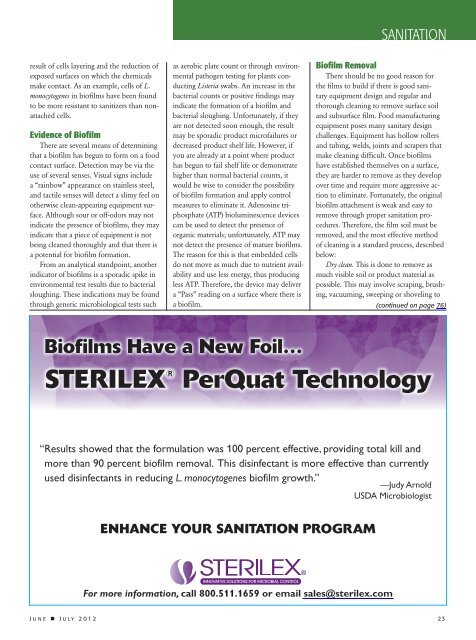Food Safety Magazine, June/July 2012
Food Safety Magazine, June/July 2012
Food Safety Magazine, June/July 2012
Create successful ePaper yourself
Turn your PDF publications into a flip-book with our unique Google optimized e-Paper software.
SANITATION<br />
result of cells layering and the reduction of<br />
exposed surfaces on which the chemicals<br />
make contact. As an example, cells of L.<br />
monocytogenes in biofilms have been found<br />
to be more resistant to sanitizers than nonattached<br />
cells.<br />
Evidence of Biofilm<br />
There are several means of determining<br />
that a biofilm has begun to form on a food<br />
contact surface. Detection may be via the<br />
use of several senses. Visual signs include<br />
a “rainbow” appearance on stainless steel,<br />
and tactile senses will detect a slimy feel on<br />
otherwise clean-appearing equipment surface.<br />
Although sour or off-odors may not<br />
indicate the presence of biofilms, they may<br />
indicate that a piece of equipment is not<br />
being cleaned thoroughly and that there is<br />
a potential for biofilm formation.<br />
From an analytical standpoint, another<br />
indicator of biofilms is a sporadic spike in<br />
environmental test results due to bacterial<br />
sloughing. These indications may be found<br />
through generic microbiological tests such<br />
as aerobic plate count or through environmental<br />
pathogen testing for plants conducting<br />
Listeria swabs. An increase in the<br />
bacterial counts or positive findings may<br />
indicate the formation of a biofilm and<br />
bacterial sloughing. Unfortunately, if they<br />
are not detected soon enough, the result<br />
may be sporadic product microfailures or<br />
decreased product shelf life. However, if<br />
you are already at a point where product<br />
has begun to fail shelf life or demonstrate<br />
higher than normal bacterial counts, it<br />
would be wise to consider the possibility<br />
of biofilm formation and apply control<br />
measures to eliminate it. Adenosine triphosphate<br />
(ATP) bioluminescence devices<br />
can be used to detect the presence of<br />
organic materials; unfortunately, ATP may<br />
not detect the presence of mature biofilms.<br />
The reason for this is that embedded cells<br />
do not move as much due to nutrient availability<br />
and use less energy, thus producing<br />
less ATP. Therefore, the device may deliver<br />
a “Pass” reading on a surface where there is<br />
a biofilm.<br />
Biofilm Removal<br />
There should be no good reason for<br />
the films to build if there is good sanitary<br />
equipment design and regular and<br />
thorough cleaning to remove surface soil<br />
and subsurface film. <strong>Food</strong> manufacturing<br />
equipment poses many sanitary design<br />
challenges. Equipment has hollow rollers<br />
and tubing, welds, joints and scrapers that<br />
make cleaning difficult. Once biofilms<br />
have established themselves on a surface,<br />
they are harder to remove as they develop<br />
over time and require more aggressive action<br />
to eliminate. Fortunately, the original<br />
biofilm attachment is weak and easy to<br />
remove through proper sanitation procedures.<br />
Therefore, the film soil must be<br />
removed, and the most effective method<br />
of cleaning is a standard process, described<br />
below:<br />
Dry clean. This is done to remove as<br />
much visible soil or product material as<br />
possible. This may involve scraping, brushing,<br />
vacuuming, sweeping or shoveling to<br />
(continued on page 76)<br />
Biofilms Have a New Foil…<br />
STERILEX ®<br />
PerQuat Technology<br />
“Results showed that the formulation was 100 percent effective, providing total kill and<br />
more than 90 percent biofilm removal. This disinfectant is more effective than currently<br />
used disinfectants in reducing L. monocytogenes biofilm growth.”<br />
—Judy Arnold<br />
USDA Microbiologist<br />
ENHANCE YOUR SANITATION PROGRAM<br />
INNOVATIVE SOLUTIONS FOR MICROBIAL CONTROL<br />
For more information, call 800.511.1659 or email sales@sterilex.com<br />
J u SterilexPerQuatAd.indd n e • J u l y 2 0 1 21<br />
5/9/12 4:50 PM 23






![Otomatik indirilmez ise tıklayınız [Download]](https://img.yumpu.com/44170525/1/190x190/otomatik-indirilmez-ise-taklayanaz-download.jpg?quality=85)










